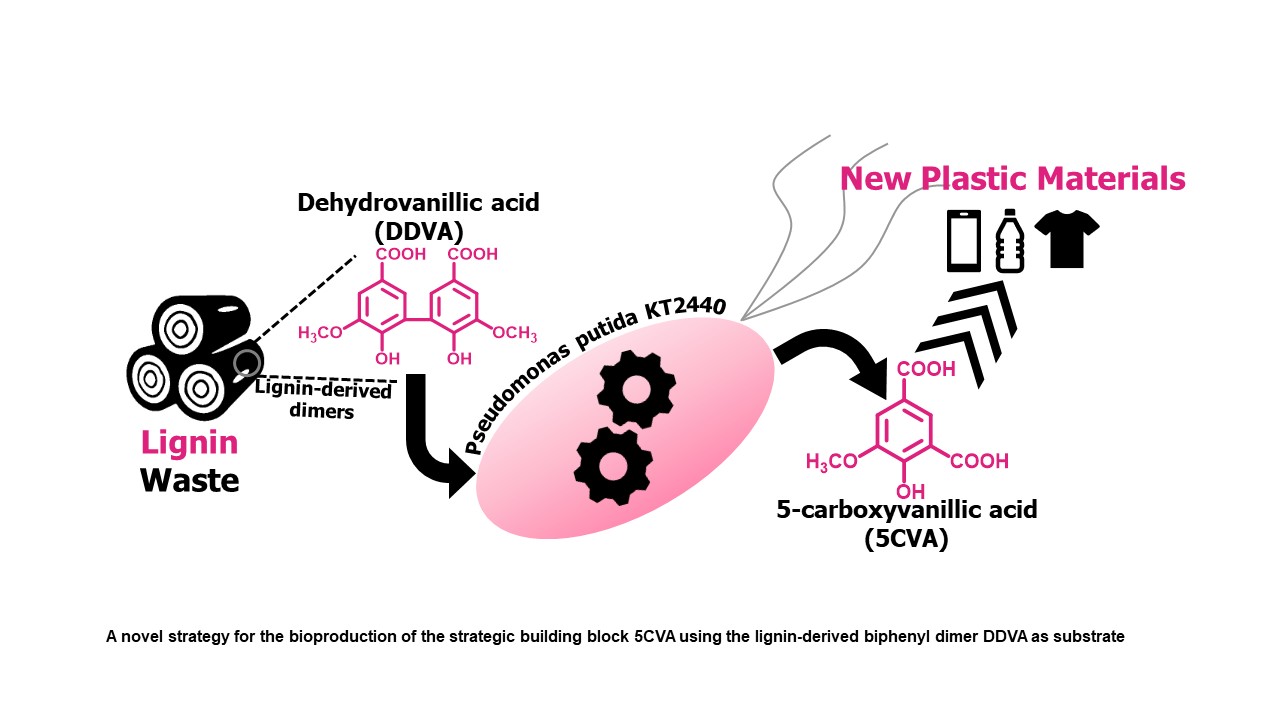
In a paper published in Green Chemistry, Dr. Eduardo Díaz's team from the Biotechnology Department of the Margarita Salas Center for Biological Research (CIB-CSIC) reported the bioproduction of 5-carboxy vanillic acid (5CVA), a key monomer for the synthesis of a new generation of bio-based plastics, from dehydrodivanillate (DDVA), a dimeric compound derived from the depolymerization of lignin found in plant waste. The bioconversion of DDVA into 5CVA using the bacterium Pseudomonas putida KT2440 highlights how metabolic engineering can contribute to designing and sustainably producing strategic building blocks for plastic polymer synthesis.
In 2023, global production of petrochemical-based plastics was estimated at 413 megatonnes, with less than 9% recycled plastic. Nearly 100% of these plastics are designed to last hundreds of years and around 70% end up as waste disposed into the environment. These data reflect the urgent need to establish a green plastic production and management model. On the other hand, lignin is another contaminant derived from using plant biomass (lignocellulose) in industrial activities such as the pulp and paper industry, agriculture, or biofuel production. Lignin is a very recalcitrant aromatic polymer, a constituent of the industrially unexploitable fraction of lignocellulose, and it is also produced in amounts of megatonnes annually.
The published research successfully links the utilization of abundant renewable waste, such as lignin, with the need to generate products of undeniable interest, such as bioplastics, in a more environmentally friendly manner. The innovation of the work lies not only in a new and more sustainable approach to the production process but also in the biotechnological strategy used and the novelty of the generated product. The study describes how the bacterial chassis has been modified to acquire new metabolic functions, including the ability to efficiently transport the DDVA substrate, a key factor for the success of this biocatalyst. The biologically generated compound (5CVA) is a structural analog of isophthalate (fossil-based) and holds great potential as a building block for generating polymers with enhanced properties compared to the widely used petroleum-based polyethylene terephthalate (PET). In conclusion, this study has developed a new bioprocess that highlights the utilization of contaminating waste, contributing to a more efficient circular economy model in our societies.
This work has been funded by the Ministry of Science, Innovation, and Universities (PID2022-142540OB-I00), the Era CoBiotech call (PIC2019-111833-2), and the Horizon 2020 Research and Innovation Program of the European Union through the Fundación General CSIC (Marie Skłodowska-Curie funding 101034263).
Reference: Gómez-Álvarez, H., del Cerro-Sánchez, C., Iturbe, P., Rivero-Buceta, V., Bugg, T.D.H., Nogales, J., and Díaz, E. 2025. Bioconversion of a lignin-derived biphenyl dimer into the strategic building block 5-carboxyvanillic acid in Pseudomonas putida KT2440. Green Chem. https://doi.org/10.1039/D4GC06537A

